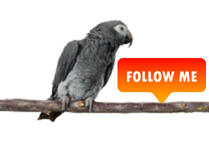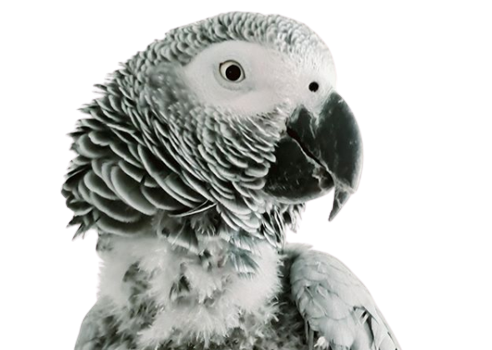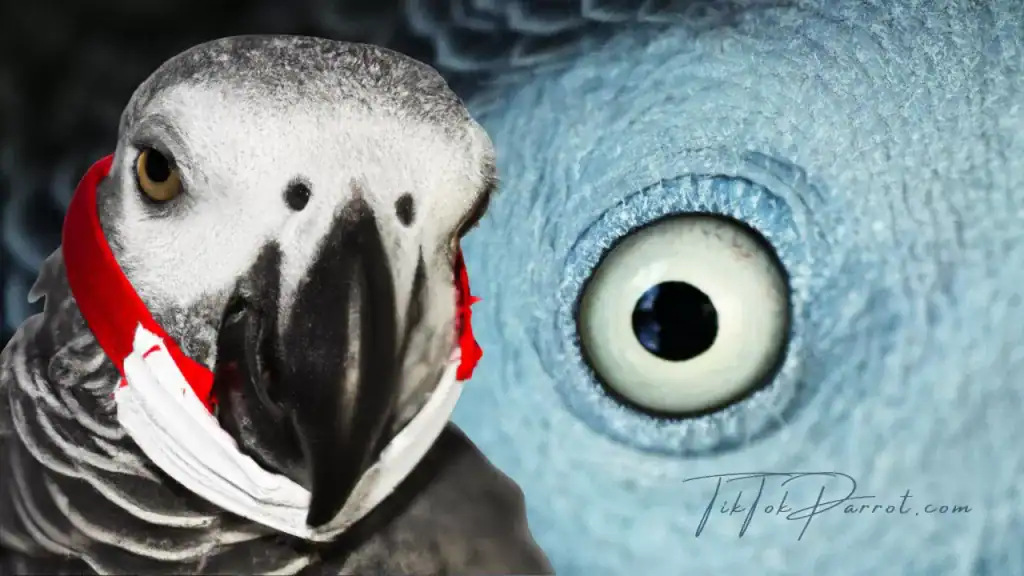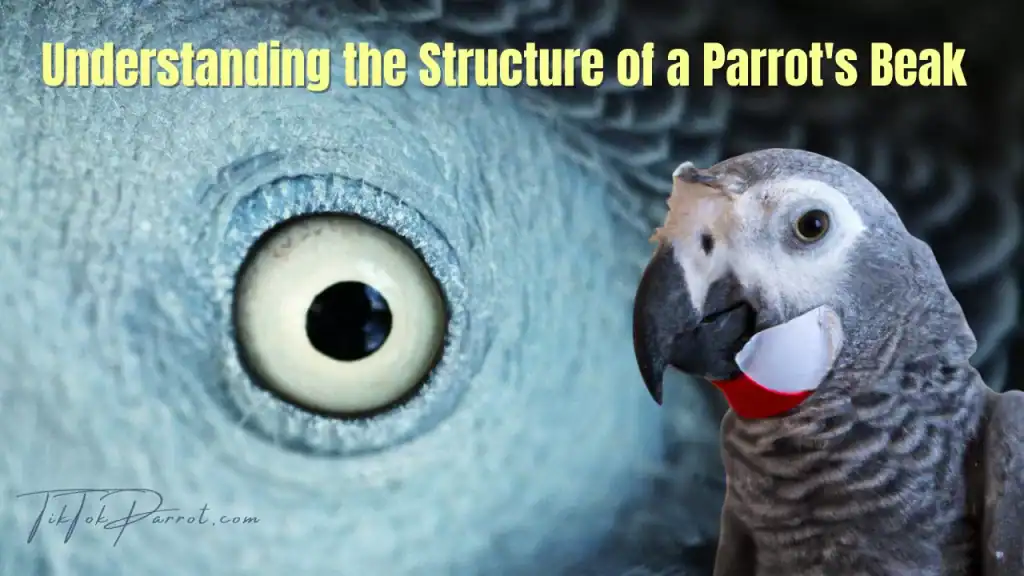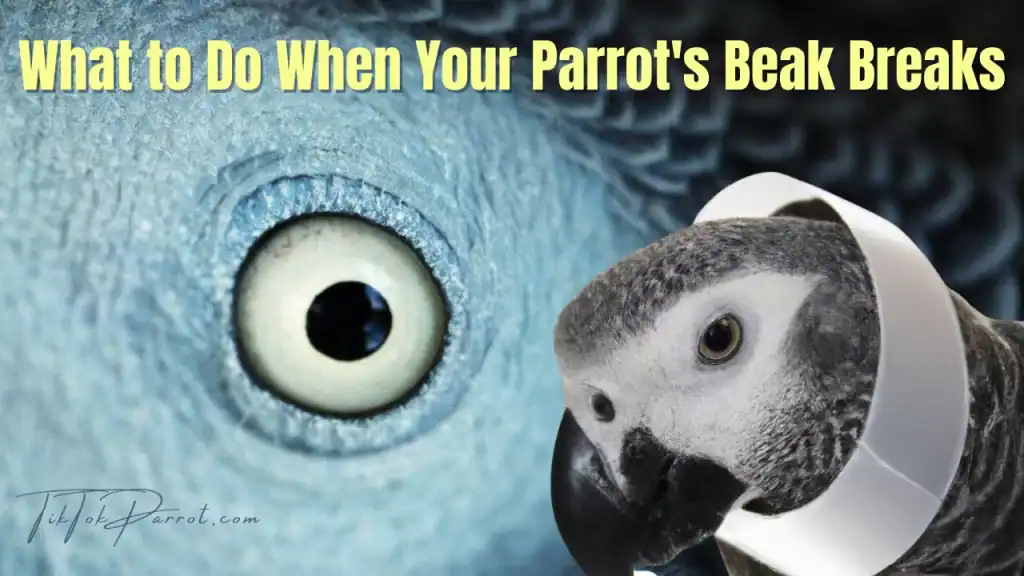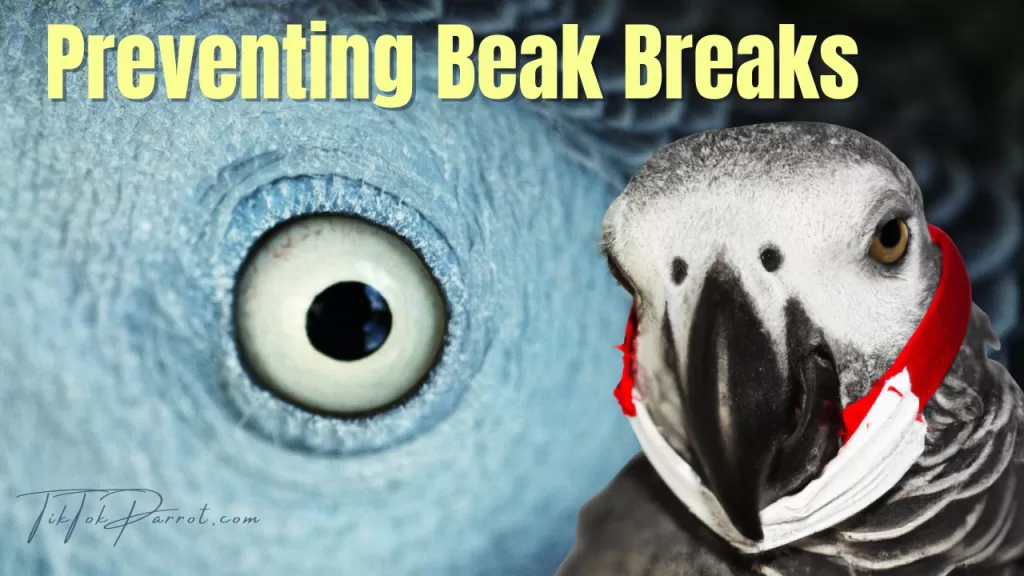Beak breakage in parrots is a problem that may leave pet owners feeling panicked and unsure about what to do. In this article, we’ll explore the structure of a parrot’s beak, common causes of beak breakage, how to assess the severity of the break, and what to do when your parrot’s beak breaks. Lastly, we’ll discuss preventive measures and answer some frequently asked questions on the topic.
Discover how to handle a parrot’s broken beak with our comprehensive guide, covering first aid, prevention tips, and expert advice to ensure your feathered friend’s health and happiness.
So you’ve had your African Grey parrot for quite some time now, right? He’s lived in your house, gotten used to humans, and is well aware that he’s not supposed to fling his waste beyond the limits of his cage bars. He’s pretty much domesticated.
Well, the reality is that even though parrots are not uncommon pets to have, they are still animals. And as animals, parrots tend to carry around what you and I like to call animal instinct. What you probably don’t know is that these birds tend to bloody their beaks in a show of territorial dominance. If you’ve seen your parrot hammering his beak on a surface, it most likely means that he’s trying to emphasize, in his own little birdy way: “I own this. This is mine. Mine, I say.”
Okay, granted, you don’t keep another parrot. He’s just one bird, so you basically can’t see why he needs to assert his dominion over his little part of the house. It’s nature, buddy. The parrots can’t control it. As far as he knows, the humans that feed him are large, feather-less birds who speak the same language in a funny accent.
Or maybe it’s not being territorial. Maybe your parrot loves the sound of glass being tapped. Maybe it’s exploring the world through hammering its beak, the same way you and I put everything in our mouths when we were babies. It doesn’t make sense, but at the time it felt like the right thing to do. I mean, birds are smart, maybe yours just decided that it would like to learn Morse code. Maybe it was playing charades, and it wanted you to guess it was a woodpecker.
Whatever the reason, the best thing you can do about it is to know what to do when your parrot does himself in and breaks his beak.
Yes, you heard me. Breaks his beak. Now, that can sound a little gruesome, but it’s best to prepare yourself for the possibility.
If you’ve noticed that your parrot’s beak has so much as a crack, don’t wait for more than 24 hours to remedy it. A bird’s beak is very rich in nerve endings, so the pain your pet is feeling is probably the same as you might feel from a very bad toothache. It’s also quite vascular, and might bleed a lot.
The first thing you should do is seek medical attention. In the meantime, you can apply steady pressure to the site of the break to ease the bleeding. Do not use superglue to try to glue the beak together, or your bird will foster a very healthy hatred of you for the rest of its life.
If the beak is still attached, do not under any circumstances, try to remove it altogether. Use sterile saline solution (preservative-free contact lens solution is an alternative) to flush out any dirt that might be stuck in the wound.
While getting your parrot to the vet’s, keep the wound clean, and try to keep it from getting contaminated, otherwise you’ve got an infection to worry about as well. A veterinarian might use a wire to reattach the beak, and then use a cast to keep it in place.
The parrot will then be tube fed until it is safe to let him regain full use of his beak. In the meantime, you might want to consider getting your parrot a new, harmless, beak-break free hobby.
If you have time, you can keep continue reading the below informative information about your bird beak which might be useful.
Understanding the Structure of a Parrot’s Beak
The Upper Mandible
The upper part of a parrot’s beak, known as the upper mandible, is curved and slightly longer than the lower mandible. It is made of a hard, keratin-based substance, which is the same material found in human nails and hair. The upper mandible plays a crucial role in tasks such as eating, grooming, and climbing.
The Lower Mandible
The lower part of a parrot’s beak, called the lower mandible, is shorter and more rounded. It is also made of keratin, and like the upper mandible, it constantly grows throughout the bird’s life. The lower mandible serves as a support structure for the upper mandible when chewing and performing other tasks.
Common Causes of Beak Breakage
Beak breakage can occur due to various reasons, such as:
- Accidents (e.g., falling or getting caught in a cage)
- Fighting with other birds
- Chewing on inappropriate objects
- Nutritional deficiencies
- Infections or diseases affecting beak health
Assessing the Severity of the Break
Minor Breaks
Minor breaks usually involve small chips or cracks in the beak. These breaks typically don’t cause significant pain and may heal on their own over time.
Moderate Breaks
Moderate breaks might include larger cracks, chips, or partial fractures that could affect the parrot’s ability to eat and groom itself. These breaks may require veterinary intervention.
Severe Breaks
Severe breaks involve deep fractures, significant damage, or complete separation of a portion of the beak. In these cases, immediate veterinary attention is necessary to prevent infection and ensure proper healing.
What to Do When Your Parrot’s Beak Breaks
Remain Calm and Assess the Situation
First and foremost, remain calm. Your parrot may be frightened or in pain, so it’s essential to approach the situation with a composed demeanor. Gently examine your parrot’s beak to determine the severity of the break.
Apply First Aid
If the break is minor and there’s no bleeding, you may be able to manage the situation at home. However, if there’s bleeding or the break is more severe, it’s crucial to apply first aid before seeking professional help. Use a clean cloth or gauze to gently apply pressure to the affected area and control any bleeding.
Seek Professional Help
Regardless of the severity of the break, it’s always best to consult a veterinarian experienced in avian care. They can assess the situation, provide appropriate treatment, and offer guidance on how to care for your parrot during the healing process.
Preventing Beak Breaks
Provide a Safe Environment
To minimize the risk of beak breakage, ensure your parrot’s environment is safe and free from hazards. Regularly inspect the cage for any potential risks, such as broken bars or loose parts. Additionally, provide appropriate toys and perches to prevent your parrot from chewing on unsuitable objects.
Encourage Good Beak Hygiene
Promote healthy beak growth and maintenance by offering your parrot a well-balanced diet and providing opportunities for natural beak grooming, such as cuttlebones or mineral blocks. Regularly observe your parrot’s beak for any abnormalities or signs of infection.
My Final Thoughts
A broken beak can be a distressing situation for both you and your parrot. By understanding the structure of a parrot’s beak, knowing the common causes of breakage, and learning how to assess the severity of the break, you can take appropriate action to ensure your feathered friend receives proper care.
Always consult a qualified avian veterinarian when dealing with beak injuries and prioritize preventive measures to minimize the risk of beak breakage.
Frequently Asked Questions
1. How long does it take for a parrot’s beak to heal?
The healing time depends on the severity of the break and the individual bird. Minor breaks may heal within a few weeks, while more severe breaks could take months to fully heal. Your avian veterinarian can provide a more accurate estimate based on your parrot’s specific situation.
2. Can a parrot’s beak grow back after breaking?
In most cases, a parrot’s beak will grow back after breaking, as the beak is continuously growing throughout its life. However, the growth rate and extent of regrowth depend on factors such as the severity of the break, the parrot’s overall health, and its diet.
3. How can I tell if my parrot is in pain due to a broken beak?
Parrots may exhibit signs of pain through changes in behavior, such as reduced appetite, difficulty eating, increased vocalization, or lethargy. If you suspect your parrot is in pain, consult an avian veterinarian as soon as possible.
4. What should I feed my parrot if its beak is broken?
If your parrot’s beak is broken, offer soft, easily digestible foods such as soaked pellets, mashed fruits and vegetables, or baby bird formula. Consult your avian veterinarian for specific dietary recommendations during the healing process.
5. Can I trim my parrot’s beak at home to prevent breakage?
Trimming a parrot’s beak at home is not recommended, as it can lead to injury or infection if done improperly. Regular beak maintenance should occur naturally through your parrot’s daily activities, such as chewing on appropriate toys, perches, and cuttlebones. If you notice overgrowth or other issues with your parrot’s beak, it’s best to consult an avian veterinarian for professional assessment and care.
Remember, prevention is key to keeping your parrot’s beak healthy and reducing the risk of breakage. By providing a safe environment, promoting good beak hygiene, and monitoring your parrot’s beak health, you can ensure that your feathered friend stays happy and healthy for years to come.
6. What can I do to help my parrot feel more comfortable during the healing process?
Provide a quiet and stress-free environment for your parrot during the healing process. Keep the cage clean and ensure that fresh water and soft, easily digestible food are available. You can also place the cage in a warmer area of your home to help your parrot feel more comfortable. Consult your avian veterinarian for further guidance.
7. How can I prevent my parrot from picking at its broken beak?
If your parrot is picking at its broken beak, you can try to distract it by providing new toys or engaging in playtime. However, if the picking continues or worsens, consult your avian veterinarian for advice on possible interventions, such as an Elizabethan collar.
8. Can infections occur as a result of a broken beak?
Yes, infections can develop if a broken beak is not treated properly. Open wounds on the beak can allow bacteria or fungi to enter, potentially leading to infection. If you notice any signs of infection, such as swelling, discharge, or a foul smell, seek veterinary attention immediately.
9. Can a broken beak affect my parrot’s ability to eat and drink?
A broken beak can make it difficult for your parrot to eat and drink, especially if the break is severe. Monitor your parrot’s food and water intake closely and provide soft, easily digestible foods during the healing process. Consult your avian veterinarian if you have concerns about your parrot’s ability to eat and drink.
10. Is it possible for a parrot to live a healthy life with a partially missing or deformed beak?
While a partially missing or deformed beak can present challenges, many parrots can still live healthy lives with proper care and accommodations. It’s essential to work closely with your avian veterinarian to address any issues related to eating, grooming, and overall well-being.
11. Are some parrot species more prone to beak breakage than others?
Some parrot species may be more prone to beak breakage due to factors such as beak size, shape, and strength. However, proper care, nutrition, and environmental safety can significantly reduce the risk of beak breakage in any parrot species.
12. How often should I check my parrot’s beak for signs of damage or disease?
It’s a good idea to visually inspect your parrot’s beak at least once a week. Look for any signs of damage, discoloration, abnormal growth, or other issues. If you notice any concerns, consult your avian veterinarian.
13. Are there any supplements I can give my parrot to promote healthy beak growth?
A balanced diet should provide all the necessary nutrients for healthy beak growth. However, if your avian veterinarian determines that your parrot has a nutritional deficiency or requires additional support, they may recommend specific supplements or dietary changes.
14. Can stress contribute to beak breakage in parrots?
Stress can indirectly contribute to beak breakage by causing parrots to engage in destructive behaviors, such as excessive chewing or biting. Reducing stress in your parrot’s environment and providing appropriate enrichment can help mitigate these behaviors and reduce the risk of beak breakage.
15. What are some signs that my parrot’s beak might break soon?
While it can be difficult to predict when a beak might break, look for signs such as visible cracks, chips, or weakened areas in the beak’s structure. Additionally, monitor your parrot’s behavior for any changes that might indicate discomfort or pain. If you suspect your parrot’s beak is at risk of breaking, consult your avian veterinarian for an assessment and advice on preventive measures. Keeping a close eye on your parrot’s beak health and addressing any concerns promptly can help minimize the risk of breakage and ensure the well-being of your feathered friend.
16. How can I tell if my parrot’s beak is overgrown?
An overgrown beak may appear elongated or have an altered shape, making it difficult for your parrot to eat, drink, or groom itself. Overgrown beaks may also cause the upper and lower mandibles to not align properly. If you suspect your parrot’s beak is overgrown, consult your avian veterinarian for an assessment and treatment.
17. Can a broken beak change my parrot’s vocalizations?
A broken beak could potentially affect your parrot’s vocalizations, especially if the break is severe or causes discomfort. However, it’s essential to consult your avian veterinarian to rule out other causes of changes in vocalizations, such as illness or stress.
18. Is it normal for a parrot’s beak to have small lines or grooves?
Yes, it’s normal for a parrot’s beak to have small lines or grooves, which are called “growth lines.” These lines are similar to the growth rings found in trees and can provide insight into the parrot’s age and overall health. However, if you notice any significant changes in the appearance of these lines or other abnormalities, consult your avian veterinarian.
19. Can a parrot’s beak become discolored? If so, what could cause this?
A parrot’s beak can become discolored due to various factors, including diet, age, and underlying health conditions. For example, a diet rich in carotenoids can cause a yellowish tint on the beak. If you notice any sudden or significant changes in the color of your parrot’s beak, consult your avian veterinarian to rule out potential health concerns.
20. Can a parrot’s beak become dry or brittle?
Yes, a parrot’s beak can become dry or brittle due to factors such as poor nutrition, dehydration, or underlying health issues. To maintain a healthy beak, provide your parrot with a well-balanced diet and ensure access to fresh water. Consult your avian veterinarian if you have concerns about your parrot’s beak condition.
21. How can I tell if my parrot is experiencing discomfort due to a broken beak?
Your parrot may exhibit signs of discomfort by rubbing its beak against objects, displaying increased irritability, or avoiding certain foods. If you suspect your parrot is experiencing discomfort due to a broken beak, consult your avian veterinarian for an assessment and appropriate treatment.
22. Can a broken beak affect my parrot’s breathing?
In most cases, a broken beak will not directly affect your parrot’s breathing. However, if the break is severe and involves the nares (nostrils) or if an infection develops, it could potentially impact your parrot’s ability to breathe comfortably. Always consult your avian veterinarian if you have concerns about your parrot’s breathing.
23. Should I remove my parrot’s favorite toys if its beak is broken?
During the healing process, it may be necessary to temporarily remove certain toys that could cause further damage to the broken beak. However, ensure your parrot still has access to appropriate enrichment to reduce stress and promote mental stimulation. Consult your avian veterinarian for guidance on which toys are suitable during the healing process.
24. How can I help my parrot maintain a healthy beak after a break has healed?
To help your parrot maintain a healthy beak after a break has healed, continue to provide a well-balanced diet, appropriate toys and perches for beak maintenance, and a safe living environment. Regularly monitor your parrot’s beak for any signs of damage, overgrowth, or infection, and consult your avian veterinarian for routine check-ups and any concerns that arise.
25. Is there a specific type of avian veterinarian I should consult for beak-related issues?
While any avian veterinarian should have the necessary knowledge and experience to address beak-related issues, it can be helpful to consult a veterinarian who specializes in avian medicine or has extensive experience with parrots. They may have a deeper understanding of parrot-specific beak concerns and can provide the most appropriate care and guidance for your feathered friend.
If you found this blog helpful, It would be great if you could share it with your family and friends who might find it useful as well.
You might like to read these as well 🙂
The Mighty Beak: Exploring the Unique Features of African Grey Parrot Beak
African Grey Parrots: The Ultimate Guide to Care and Training
African Grey Parrot Male or Female? (Determine Gender of African Grey)
The Surprising Benefits of Owning an African Grey Parrot
Understanding of Grey Parrot’s Body Language
The Importance of a Cage for Your African Grey Parrot
Mastering the Art of Taming an African Grey Parrot
Is Your African Grey a Jealous Bird? Here’s What You Need to Know!
The Mesmerizing Eyes of African Grey Parrot & What They Can Tell
Unlock the Secrets of Choosing the Perfect African Grey Parrot
The Battle of the Birds: African Grey Parrot vs Macaw
The Battle of the Birds: African Grey Parrot vs Crows
Winning Parrot Names: How to Choose a Name That Strengthens Your Bond
The Secret Life of African Grey Parrots: What You Need to Know Before Owning One
For more useful content about African grey parrots, you can subscribe my site with your email to get notification upon publishing a new blog, the subscribe box you can see on the right side of this page. Also if you get an alert on your web browser while browsing my site, allow it and that will also give you an alert whenever I publish a new blog. 🙂
Stay safe and much love !

